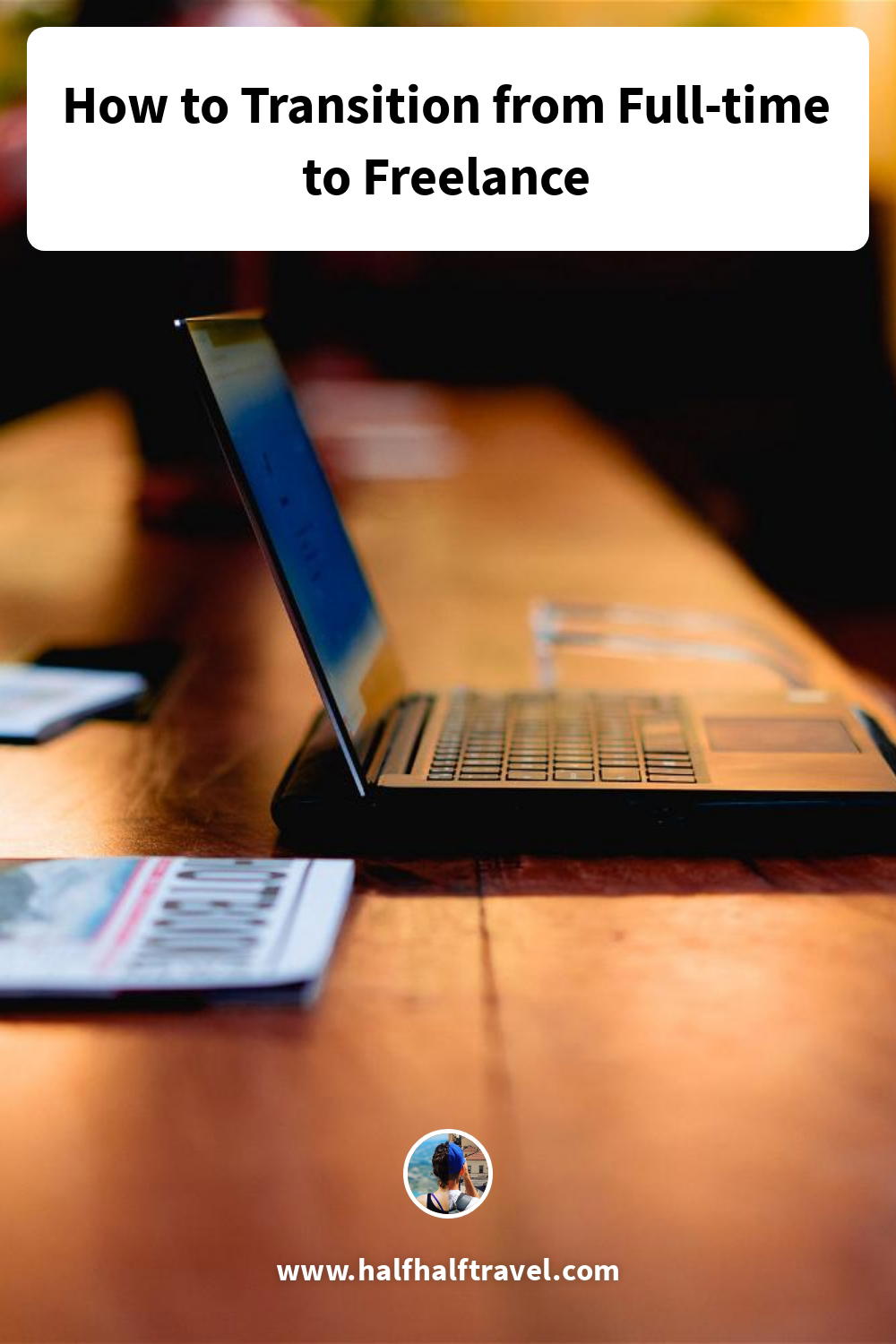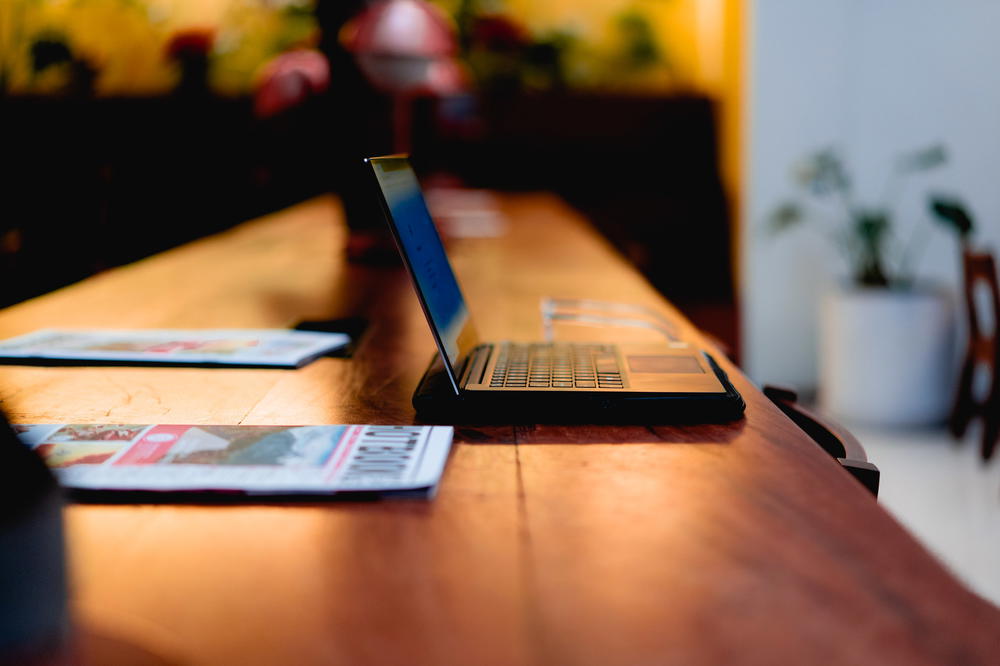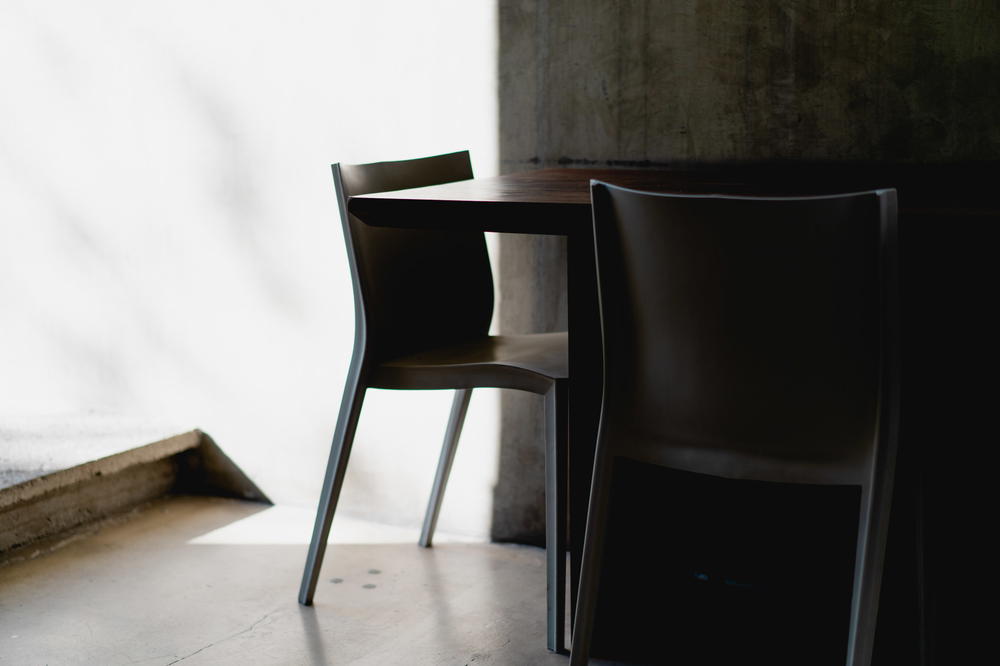How to Transition from Full-time to Freelance

Looking for how to transition from working full-time to freelancing? See our best tips for how to start freelancing from scratch, secure freelance clients and when to go full-time freelance.
This article may contain affiliate links. We earn a small commissions when you purchase via those links — and it's free for you. It's only us (Becca & Dan) working on this website, so we value your support! Read our privacy policy and learn more about us.
Table of contents
- How to start freelancing
- Decide which of your skills you want to offer
- Use your network to find clients
- Determine how you will price your freelance services
- What’s the difference between charging hourly and charging per project?
- Be ready to negotiate your prices as a freelancer
- Understand the difference between short- and long-term freelance contracts
- Create a freelance contract agreement
- Create a freelance invoice template
- Understand your potential freelance schedule
- What you give away by not working full-time
- Benefits of working as a freelancer
- Freelancing while working full-time
- Give proper notice to your full-time employer
- Creative ways to find your first freelance client
- How long does it take to start a freelance business?
- Get to work!
Moving your steady 9-to-5 job into a freelancing career can be a daunting task. There is so much to consider, between ensuring that there is a constant flow of income to getting a constant flow of work.
In this article, I’ll walk through some of the critical aspects of starting to freelance for the first time. I’ll share some insights into how to leave your full-time job and transition into a successful freelance career.
In 2016, after developing a career since 2010, I decided to start working for myself. My transition plan was calculated, as I had a period of time in which I was consulting while working full-time.
Doing it this way was a lot of work, because I was responsible for deliverables for two commitments; however, this allowed me the peace of mind that I would have some financial security when I transitioned out of my full-time position, just in case things went in any unexpected directions.
This article and this advice will be for you if you work full-time for a company or full-time employer and you want to start working for yourself full-time.

Check out our guide on the pros and cons of freelancing as you’re planning out your employment transition!
How to start freelancing
Everyone has a different skill set that they can apply to freelancing. In addition to skill, or various skills, the reason for wanting to freelance is also different for everyone.
Getting started is simple. If you are a landscaper, you can talk with your neighbors and see if they’d like to use your services to improve their lawns. How can they trust that your services are excellent? Work on your own lawn, and show them!
For whichever freelance service you choose to offer, make sure that you can first prove that you’re an expert in the field, or that you have a strong and dedicated passion for your service.
If you’re looking for someone to help you with your taxes, you’d want to make sure that you pick the best accountant or an accountant who is eager to help get you the most deductions.
The most important thing to know when starting to freelance is that someone is hiring you because they believe that you can do the best job possible!
The actual act of starting is as simple as “putting yourself out there.” Let everyone know that you have a skill that you’d like to provide to others.
Sometimes freelance jobs will naturally “find you.” Back in our landscaping example, if you landscape your lawn and your neighbors or people in your town like what you’ve done, they might ask you to do the same for theirs. That’s how the cycle begins.
Many full-time freelance careers start as ‘side hustles’ or ‘freelancing on the side.’ You can see more about having a side hustle, as it’s one of the biggest remote work trends this year.

Decide which of your skills you want to offer
Everyone has different skills and different areas in which they can claim expertise. These skills can start as hobbies.
For example, I started learning photography when I was 12 years old. I stuck with photography for many years, experimenting with different styles and categories.
I used to shoot sports photography. After sports, I started learning landscape photography. I transitioned into learning all about travel photography. In 2017, I was hired by a catering company in Manhattan to shoot photos of food for a catering app. Most recently, I started getting into family portraits, couples photo shoots and headshots in NYC.
Now, I am able to offer freelance photography in a variety of different capacities to a variety of different clients. Having had so much experience in the past with my different styles, I am able to promote examples of the types of photos that I’ve taken in the past.
My progression with photography can easily be applied to any other skill set. The idea is picking a topic and focusing on learning or being aware of all of the different types of possible variations.
At a high level, you want to be able to say, “I offer freelance marketing.” Someone might then say, “Great, can you help me market my Shopify store?”
You want to be able to confidently say, “I can help! I recently worked on a Shopify site and increased sales by 65% for my client.”
Using the same marketing example and asking the same question as above, you don’t want to say, “Oh, I only am able to offer marketing for car dealerships.”
Here’s why: even if you don’t have e-commerce experience, you can say something like, “Great, I’ve been able to increase the conversion rate at this car dealership, and I believe I can apply the same creative campaigns to your store.”
There are some cases when being able to offer a specialized skill can be useful. One example can be if you speak a rare second language. Becca used to work in translation services, and sourcing people who can translate certain Aztecan languages is difficult (as an example).
If you can translate something rare, you’ll be able to offer that service. You’ll also be in high demand when the need is there. The downside is that you might not get too many clients, as there might not be a lot of work for that translation service on the whole.

Use your network to find clients
In order to successfully complete an employment transition from a full-time job to working full-time as a freelancer, you first need freelance jobs.
One of the best ways to start getting freelance jobs is to network and meet new people, whether remotely or in person! You can reach out to friends and family. You can talk with your neighbors. You can talk to your barber or people at your gym. Talk with whomever you can, and let them know that you can freelance.
But first, have your skill ready to go and have a sample of work easily accessible. By this, I mean that you should be able to pull up a sample of your work on your phone, whether it’s a garden you designed, a website you built, a photo shoot you directed or a portrait you painted.
Back to landscaping, if someone in your network is talking with someone who needs landscaping, they’ll think of you if you make it known that you offer landscaping services. The person of interest can easily drive by your property and see the work you’ve done to your own house. If they like what they see, they’ll hire you.
The same process works for any skill set, like marketing, photography, design and so on.

Determine how you will price your freelance services
Pricing is classically one of the hardest things to figure out as you start freelancing. And this is for a good reason! Pricing depends on every situation.
A good ground rule to start with is to never be taken advantage of. This can include working for free, but it’s not necessarily limited to such. For example, I’ll “exchange” work all the time, if both parties benefit from it.
Becca and I often promote products and experiences on our Instagram account (@halfhalftravel) if it’s something that we believe in. Sometimes, companies don’t have a marketing budget to pay us, and if the experience or product is something that we value, we don’t accept any monetary payment for their offer.
So in that example, it works for us to do a little bit of work and receive something that provides or adds value in our lives.
Being paid in “exposure” also doesn’t count. “Exposure” means like if a client re-posts a photo you took of their backpack on their Instagram account and tags your account, saying it’s great for getting your name and brand out there. (This is generally not true, nor worth your time).
There’s a running joke for photographers that “exposure doesn’t pay rent.” To prove this point, we asked our landlord and found out that he doesn’t accept exposure payments for rent (okay, just kidding).
Now that there’s a dollar amount attached to certain forms of work, how do you figure out what to charge?
There are a lot of online calculators and estimators out there (so many, in fact, that I won’t link to any). I don’t think they apply to most situations. Here’s why.
In my experience, clients have an idea of what they’d like to spend. They’re looking to hire you because they believe that you’re the right candidate to complete the task at hand in the best way possible.

Budget and clear expectations are the two criteria to match up with in order to make a notable freelance connection with a client. If there is a mismatch between those two things, I don’t believe that the relationship will be very stable.
You’ll never want to be groaning that your client isn’t paying you enough, and your client will never want to think they’re overpaying for services they could have found elsewhere for less.
If a client has a low budget, and you accept the offer, your earning potential with that client will be much lower for the time commitment that you spend working with that client. If you spend 20 hours per week with this client, you’re taking away valuable time away from potentially earning twice as much.
If you accept an offer to work with a client with loose expectations, you might have to work more hours and honor multiple revisions of some scope of work. This time spent is time taken away from other types of work.
All of the above was a long way of saying, “charge what you think you’re worth.” Don’t knock your rate down a considerable amount, but it’s okay to provide a 10-20% discount for the right client. Make it understood that on the next contract, the rate will likely go up to your regular rate, or to market rate.
If you want an exact figure, try to reverse-engineer your salary, in terms of an hourly rate. Although, keep in mind that this does not account for the market rate for a specific type of professional service.
Let’s say you’d like to make $100,000 per year. Well, there are roughly 250 working days in a year. Given that you want to take 10 days off, let’s call it 240 days.
Now, let’s say that you only book yourself 75% of this time. We’re at 180 days. This is $555/day or about $70/hr. If this was the case, I would estimate my rate at between $70-$100/hr.
The above is a highly general estimate! For web developers, I would start a rate at $75/hr and the more senior you get, you can start charging anywhere between $100-$150/hr. Some specialized skills can start to charge even more, like rare skills, highly technical skills and skill sets that combine two, or even three, types of useful skills for a client’s needs.
Use this as a starting point and adjust your rate based on quotes that you send out. If everyone quickly accepts your rate, you can start increasing your rate in increments of 25%. If clients often counter your offers, maybe you’re charging too much for the service that you’re providing.
You can either adjust your service expectations, or adjust the types of clients you’re approaching, or revise your rate.
When you work full-time, your company usually pays for a lot that you don’t see. You may want to adjust your rates depending on your expenses. For example, your company pays for your office space, they can sometimes pay for your professional development, they pay to recruit you and they pay to give you time off.
They also pay for your coffee and office snacks (depending on where you work and which type of office environment you’ve been used to).

When you work for yourself, all of those things that a company usually pays for are now “on you.” It’s a common misconception that your hourly rate should be your salary divided by 365. This absolutely is not the case for all of the points mentioned above.
Running a business is expensive and your rate should reflect that. There’s lots of admin time, like invoicing, sending proposals, following up on invoices and figuring out your own logistics, like WiFi, or how you’ll set up a home office.
To learn even more about how to set your rates, see our guide on how to price your freelance projects!
What’s the difference between charging hourly and charging per project?
Now that we’ve covered how to determine and price your services, let’s touch on if you should be charging hourly or on a per-project basis. This is a critical part of starting your freelance business, as you may never have had to price services before.
Personally, I almost never charge hourly. This, however, comes from a good bit of experience in knowing how to estimate my time and knowing how much a specific service should cost. It took years to get there.
Here’s how (and why)!
With one of my first freelance projects, I learned about the project scope, estimated that the project would take 40 hours, and submitted a proposal at a flat rate of $7,500. I knew that the project would include a lot of collaboration, so included a lot of buffer time for that. The client INSTANTLY accepted.
Oops, big mistake.
I didn’t calculate the actual time that it took to complete the project, but it was probably 10 times what I had calculated, and maybe more, of what I initially thought. This time was mostly because I didn’t anticipate a lot of client revisions that I would have to incorporate and review. Like, a lot of them.
What I would have expected to be a great hourly rate turned out to be hardly worth it for the work that I put in. This was a shame.
As someone starting out, charging hourly could have been a good idea for my work. It would have been nice to see an itemized list of how long I spent in meetings, how long I spent on project planning, how long I spent on executing and how long I spent on revisions.
But most of all, in this scenario, the client would have been able to streamline the feedback in a way that was most efficient for their budget.
Looking back, a few things could have changed to be successful at the project. These are the things that I’d like to recommend to you.
- For smaller projects, if you’re starting out, charge hourly. Find a rate that makes sense to you and a rate that your clients agree with. Don’t lock yourself in for too many hours at this rate. You can phrase this rate out as a discovery phase or an introductory rate.
- For bigger project scopes, split up the work and deliverables into smaller milestones. If the scope starts to increase, make sure that you communicate this well. You want to stay on track and don’t want to have to ask for more money, or take any things off of the table.
I think the most important takeaway is knowing that there is value in what you’re providing. It may take you 30 minutes to solve a task, whereas it may take someone 8 hours to solve the same task.
Or, the 2 hours that you spend helping a business can save them thousands of dollars every month.
The bottom line is that your skills and experience are important to a business. If an hourly rate is easier for your clients to work with, make sure your hourly rate includes some of those experience points. If you have a valuable service, make sure that your project rate includes your value.

Be ready to negotiate your prices as a freelancer
There may be times when you have an alignment issue with what you’d like to get paid vs. what the client has for a budget.
In this case, you’ve entered into the world of negotiation. I think the value that you negotiate is not as important as the expectations that you set for this client.
You don’t want to lock in a low rate for a year, because then you’re stunting your growth and potential income. Instead, you may want to negotiate for this instance, and leave yourself room to grow for future projects.
It’s common for clients to want you to come down on your price. Every client wants to save on price and spending. If your clients accept every offer without hesitating, then I suggest a plan to increase your rates, as I mentioned before in how to price your services.
It’s also okay to be firm on your pricing. To limit any back and forth, you can provide pricing tiers or itemized pricing. If you offer multiple services, then instead of negotiating your rate, it’s better to negotiate your deliverables.
Remember: everything can be negotiated.
Understand the difference between short- and long-term freelance contracts
As a freelancer, a healthy business can be structured in a lot of different ways.
Some freelancers are okay with stacking lots of clients to fill their years. Family and portrait photographers may have lots of clients per year, and per month. Some of these clients may be repeat clients! Other freelancers, like video editors, may be working on one project for months at a time.
Short-term and long-term contracts have pros and cons of their own.
Short-term contracts are a good way to get a lot of experience with a lot of different clients. They require a lot of admin work, in order to keep everything organized. Depending on your freelance business, some of these contracts may be repeat business for you, which would be great!
Long-term contracts are a good way to secure steady income for a set amount of time. You’ll know exactly how much you’ll make for a set amount of time. You probably won’t have too much admin work when only dealing with one client. If your client doesn’t renew your contract, or if it naturally expires, your primary source of income is 0.
A good freelance business has a mix of clients. I always tried to plan to have one primary client that made up most of my income. I had a few clients each month that supplemented the rest. This way, while I was looking for a bigger contract to pick up next, I still had a steady stream of income. It was also a pretty good setup for when I was working remotely and traveling as a freelancer.

Create a freelance contract agreement
Contracts are critical to protecting yourself while you freelance. A signed contract will provide you with the terms needed to work with your clients.
When you worked full-time, you likely signed a contract. Take a look at that, if you have one!
Full-time contracts contain a lot of information, but usually contain specific information about intellectual property, effort, indemnity and more. When you work for yourself, it’s a good idea to understand what the specifics in these contracts mean, so you can apply them to your contracts in the future.
If you’re dealing with a lot of money, it’s a good idea to consult a lawyer to design a contract best for you.
Depending on the size of your client’s company, organization or firm, they may provide a contract for you to sign.
If you’re working for a startup or a small business owner, a lightweight contract may also be okay. These are sometimes referred to as project agreements.
I was an in-house freelancer for a company that had a legal team. Each scope of work that I signed on for was amended to my contract that they wrote. The contract protected both parties for making sure that I was doing the work, and that the work that I was doing was their property.
I’ve done a lot of work for small companies for which my proposal of work was enough of a working agreement to get started. I clearly outlined what I was going to be delivering and wrote out a payment schedule. Both parties agreed, and signed. This represents one of the more simple situations. It worked out, and everyone was happy.
I’ve never had to exercise pursuing legal actions with any type of proposal or contracts. I hope you never have to do that either!
But again, I want to state that if you have any specific legal questions about contracts, please talk with a lawyer, as they will have the best information specific to your situation.
Create a freelance invoice template
Now that you’ve done great work, you get to invoice your client! This is exciting stuff. There’s a few things to know that are helpful to include on your invoice. Let’s explore.
Before you get started with your invoice, always try and ask what the client’s payment schedule is. Some clients may have Net30, 60 or 90! These all pertain to the number of days after the ‘invoice date’ for when your money would be remitted to your account.
It’s important to know when you’ll get paid so that your invoice can reflect that payment schedule.
Understand which payment methods your client requires of you. This may be PayPal, direct deposit/ACH, physical check or something else (Payoneer? Zelle? There are so many out there). Always include this payment method on your invoice so that it’s clear and aligns with what your client expects.
Include a clear description of the work that you’re invoicing for. Let’s say that you’re a freelance car mechanic and charged someone $1,000. It’s helpful to see an itemized list of charges, like labor, parts and specifics about the work done. It’s not as helpful to nothing more than, “I fixed your car. It costs $1,000.”
This is your opportunity to list out any expenses that you can include, as well as a description of the work that you completed. I like to attach the original scope of work as a reminder of the service that I provided. There also may be incidentals that your client said you’re welcome to charge for, like transport, licenses to software, space rentals, tools needed, etc.
Tax services, like Quickbooks, AND.CO, Freshbooks and some others can help automate and format your invoices. Personally, I use Google Docs and create a template for each client. It’s a manual process, but I also don’t send too many invoices these days.
Did you know that you can open a new Google doc by visiting docs.new?

Understand your potential freelance schedule
Scheduling your time is a new skill that you now have to do on your own. As a freelancer, you wear a lot of hats. You’re your own project manager, among other roles you’ll have to assume.
How you manage your time is up to you, ultimately, but it’s something that you’ll have to do in order to stay on track.
To be the most effective, I try to get my admin work out of the way in the morning or at the end of the day. This can include things like, invoicing, responding to emails, looking for new work and so on.
When I try to intertwine that with my regular scheduled work, I learned that I get distracted easily and lose a lot of time between all of the context-switching.
There may be days when you’re only responding to emails. There may be days when you’re head-down, trying to meet a deadline. It’s important to be on top of your schedule so that you can work in the best way possible as a freelancer.
If you have any gaps between projects, check out our guide for what to do in between freelance projects.
What you give away by not working full-time
As a freelancer, there’s a lot that you give up after leaving a full-time job. Depending on the company that you worked for, you might be leaving a lot of benefits behind. Things like a 401K-match, maternity leave, PTO, a professional development budget and more are all things that your tiny new business may not offer its owner (you).
Read more about if full time is really better as we answer the question, “How many hours is really considered part-time, and is full time better?”
You also leave behind a steady stream of income, which is probably one of the best perks of a full-time job (but as we discuss, working full-time also means you’re “giving some things away”).
We’ve all had times when we work full-time and there is a slow time. You can usually spend this time at the office, catching up with tasks that don’t provide as much business value, but are nice to do, maybe to “get ahead” before your busy season.
For me, working full-time, this usually means cleaning up old code or improving the design of old pages. These are tasks that relate specifically to my line of work.
You also give up collaboration when you work as a freelancer full-time. Because you may now be the only person working on a project, there’s often not a lot of people to collaborate with. You’re being hired because you’re the expert.

Benefits of working as a freelancer
The biggest benefit of working as a freelancer is having flexibility and freedom. In my years of working as a freelancer, I would often have long breaks when I would work on personal projects. I was not being paid for these breaks, but I would spend the time learning skills that I could market to potential clients in the future.
One of the other potential upsides of working as a freelancer is that your earning potential is much higher, so to speak. If you’re charging based on value that you provide, you can start to earn more than you would by working full-time.
As a freelancer, you can choose which sector to work with. If you like non-profits, you can target non-profit organizations to work with. If you like sports, you can work with sports agencies. You can also experiment with various sectors to see if you can provide any new perspectives and values.
Of course, more and more clients can be gained and won after you have a good list of clients on your resume and sample projects to back it all up.
To really make your resume stand out, check out read.cv!
Freelancing while working full-time
It’s a great idea to have some freelance experience before quitting your full-time job and freelancing. This gives you a benchmark of what to expect when you freelance full-time.
In addition, you’ll have a financial cushion behind you if you have a slow start.
One of the best ways to pursue a freelance career, after a full-time career, is to build up a business while you have a full-time job. This is a lot of work, because it means picking up clients during your off-time, like mornings, nights and weekends. It can be tiring, and kind of draining, but if it lines up with your goals, then it can be worth it.
In a perfect world, the month before your full-time to freelance transition, work on signing a contract that you know can sustain your expenses for a few months. This way, you buy yourself some time to continue to grow your business and pick up new clients.
When I made my first employment transition into freelancing full-time, I waited until I signed two contracts that would pay for my expenses for the next six months. After my contracts were signed, I properly made my full-time exit from my full-time employer.
This is easier said than done, though. During my time working full-time and freelancing, I probably worked 16 hours a day. It was like working two full-time jobs. I would recommend some balance if you can! In fact, here’s our tips for how to avoid burnout while working remotely.
Looking for more ways to balance life and work? Our list of how to achieve work-life balance when working from home or working remotely is a great start.
Give proper notice to your full-time employer
Now that you’ve made up your mind to freelance full-time, please give your employer proper notice! You will want to maintain a level of professionalism for your reputation. You may encounter old coworkers in a freelance capacity down the road and you certainly want to figure how to not burn any bridges.
If you freelance in a similar space compared with your previous full-time job, you don’t want to create a bad name for yourself, either!
Depending on how long you’ve worked for a company, try to give two to four weeks of notice. This way, you can properly document your old responsibilities and help find replacements for the work that you were previously doing.
Creative ways to find your first freelance client
If you’ve built up a good working relationship with your full-time employer, there might be an opportunity to work as a freelancer for that company. Your position might be hard to replace, and your skill set might be a unique one based on what you’ve learned and excelled at over the years.
You can leverage yourself and your skills to your company and have them hire you for your first job. This is one of the easier transitions because you should already have a good working relationship with your (old) coworkers.
Both Becca and I have done this in different capacities and have learned from a lot of other people who have done something similar to this in the past. It’s also what helped us to go remote and travel for so long.
You can also reach out to some of your old coworkers and see if they are looking to hire for the skill that you provide. Because they’ve worked with you in the past, they can vouch for you!
How long does it take to start a freelance business?
A freelance business can start as soon as you start your first freelance contract. Once you’ve signed a contract (or scope of work) you’re officially a freelancer!
It may take a lifetime to run a successful freelance business, but it’s important that you take the first steps and start learning the ropes.
Once you’re actively a freelancer, you can start to plan for how to want to run your business and figure out ways that you can save time and money.
Did you know that you can save money by working from home? We think this is an ideal setup for freelancers if you don’t have a coworking space close to your home.

Get to work!
Part of the fun about being a freelancer is the flexibility and freedom that you can afford now that you work for yourself.
Freelancing is a lot of work and I’m glad that you’ve decided to learn how to do it. Transitioning from your full-time career to freelancing is one of the best ways to get started, because you are giving yourself a potential head start, in a lot of different ways.
Good luck! You’ve got this.
You may also like
-
![A woman working at a desk in a small room.]()
How Many Hours Is Considered Part-time? Is Full-time Better?
What are the pros and cons of working part-time, and what are the benefits of working part-time vs. full-time? Find out here, as we discuss if employers prefer full-time or part-time employees.
-
![A laptop computer on a table with a cup of coffee.]()
14 Pros and Cons of Freelancing Vs. Working Full-Time
What are the pros and cons of freelancing? Are there advantages and disadvantages of freelancing? See the benefits of freelancing, and differences between being freelance vs. an employee.
-
![A woman working on a laptop in a conference room.]()
What to Do in between Freelance Projects
What should you do with downtime, as a freelancer? Here are the best ways to make the most of downtime when you’re in between freelance projects in order to stay productive when waiting for your next freelance job.
-
![]()
How to Balance Freelance Work While Working Full-Time
Can you freelance while working full-time? Yes! Here are our best tips for how to manage freelancing with a full-time job and how to balance your 9-to-5 with additional freelance clients.
-
![A room with a table, chairs, and a tree.]()
How to Transition into a Full-Time Job after Freelancing Full-Time
Going back to the 9-to-5 after freelancing full-time is hard, which is why we’re sharing tips for going from freelance back to full-time, and returning to full-time work after ending a freelancing career.
-
![]()
How to Explain Freelance Employment Gaps in an Interview
How do you explain an employment gap as a freelancer? To justify a freelance employment gap in an interview, use these examples and tips to explain any gap between full-time jobs.















